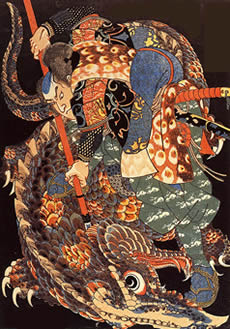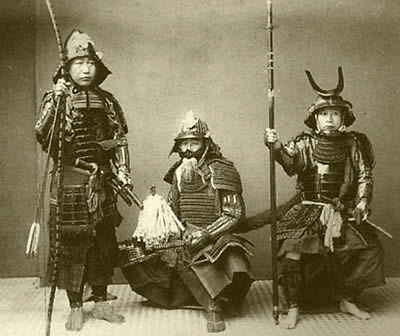World History
When Tokugawa Ieyasu defeated Ishida Mitsunari at the Battle of Sekigahara in October 1600, Bushido, the “way of the warrior,†which his victorious samurai followed, was just reaching its apogee. (Bushi, which means “warrior,†is another term used interchangeably with samurai, which means “one who serves [a lord].â€)
It is an unwritten code that governed the lives of the upper-class warrior and was more severe than the law code governing the common people. In 1603, Tokugawa was recognized as the shogun, or military ruler of Japan, by Emperor Go-Yozei.
A samurai served in the household of a daimyo, or lord. A samurai whose lord’s line was extinct became a ronin, or masterless samurai. As a result of prolonged warfare between lords before 1603, there were many ronin in Japan.
Bushido’s origins can be traced to the first appearance of Zen Buddhism in Japan in the 12th century. Zen Buddhism was widely adopted by an emerging warrior class.
Zen gave samurai the moral and intellectual strength to follow a demanding calling in life, for which only death could free the true warrior. Bushido emphasized strict loyalty to one’s lord, even to the point of death in battle. And, if faced with disgraceful surrender, Bushido called for the samurai to meet death by his own hand.
 In seppuku, commonly called hara kiri in the West, a samurai disemboweled himself with a short dagger, after which a trusted friend or comrade, acting as his second, would sever his head with a blow of his sword.
In seppuku, commonly called hara kiri in the West, a samurai disemboweled himself with a short dagger, after which a trusted friend or comrade, acting as his second, would sever his head with a blow of his sword.
Bushido also demanded the samurai lead a clean and honorable life, protect the weak, abstain from riotous living and drunkenness, conscious that he was the representative of the daimyo he served, whose heraldic badge was always displayed prominently on his clothing.
Aside from giving him a code of honor, Bushido made the samurai a fearsome warrior with his sword. He strove for mental discipline achieved through swordsmanship akin to that achieved through the pursuit of Zen.
Perhaps the greatest statement of Bushido and the sword in the Tokugawa period is found in 1716’s Hagakure, or “hidden leaves.†It is a compilation of the philosophies of Yamamoto Tsunetomo that was sanctioned by the Tokugawa shoguns for its accurate representation of the prevailing philosophies during its reign. It blended the discipline and insight of Zen with the ancestor worship taught by Confucianism.
- Samurai
Samurai The originally Chinese term samurai means “a person who serves in close attendance to nobility.†Its original pronunciation was saburau, which later became saburai. Warriors known as bushi or samurai dominated the Japanese landscape...
- 47 Ronin
47 Ronin A ronin was a masterless samurai who had lost his privileged status in society. The tale of the 47 Ronin has become one of the central myths in Japanese history. It concerns a supposedly real-life story from the beginning of the 18th century...
- Japan Tokugawa Bakuhan System
Tokugawa Bakuhan System The Tokugawa shoguns were the de facto rulers of Japan from 1603 to 1867, when emperors, symbolic rulers of the country, bestowed the title of shogun on the Tokugawa clan. After the Battle of Sekigahara in 1600, the first shogun,...
- Ritual Suicide
Ritual Suicide. This short article has information on the ritual suicide practice known as Seppuku (or Hara-kiri). It was normally practiced by samurai in medieval Japan. The article notes, "To the samurai, seppuku--whether ordered as punishment or chosen...
- Samurai & Bushido
Studying Japan? Here's a great two minute clip on the Samurai and the Code of Bushido from the History Channel. Thanks to Star Wars in the class for tweeting the link....
World History
Bushido, Tokugawa Period in Japan
 |
| Bushido, Tokugawa Period in Japan |
When Tokugawa Ieyasu defeated Ishida Mitsunari at the Battle of Sekigahara in October 1600, Bushido, the “way of the warrior,†which his victorious samurai followed, was just reaching its apogee. (Bushi, which means “warrior,†is another term used interchangeably with samurai, which means “one who serves [a lord].â€)
It is an unwritten code that governed the lives of the upper-class warrior and was more severe than the law code governing the common people. In 1603, Tokugawa was recognized as the shogun, or military ruler of Japan, by Emperor Go-Yozei.
A samurai served in the household of a daimyo, or lord. A samurai whose lord’s line was extinct became a ronin, or masterless samurai. As a result of prolonged warfare between lords before 1603, there were many ronin in Japan.
  |   |
Bushido’s origins can be traced to the first appearance of Zen Buddhism in Japan in the 12th century. Zen Buddhism was widely adopted by an emerging warrior class.
Zen gave samurai the moral and intellectual strength to follow a demanding calling in life, for which only death could free the true warrior. Bushido emphasized strict loyalty to one’s lord, even to the point of death in battle. And, if faced with disgraceful surrender, Bushido called for the samurai to meet death by his own hand.

Bushido also demanded the samurai lead a clean and honorable life, protect the weak, abstain from riotous living and drunkenness, conscious that he was the representative of the daimyo he served, whose heraldic badge was always displayed prominently on his clothing.
Aside from giving him a code of honor, Bushido made the samurai a fearsome warrior with his sword. He strove for mental discipline achieved through swordsmanship akin to that achieved through the pursuit of Zen.
Perhaps the greatest statement of Bushido and the sword in the Tokugawa period is found in 1716’s Hagakure, or “hidden leaves.†It is a compilation of the philosophies of Yamamoto Tsunetomo that was sanctioned by the Tokugawa shoguns for its accurate representation of the prevailing philosophies during its reign. It blended the discipline and insight of Zen with the ancestor worship taught by Confucianism.
- Samurai
Samurai The originally Chinese term samurai means “a person who serves in close attendance to nobility.†Its original pronunciation was saburau, which later became saburai. Warriors known as bushi or samurai dominated the Japanese landscape...
- 47 Ronin
47 Ronin A ronin was a masterless samurai who had lost his privileged status in society. The tale of the 47 Ronin has become one of the central myths in Japanese history. It concerns a supposedly real-life story from the beginning of the 18th century...
- Japan Tokugawa Bakuhan System
Tokugawa Bakuhan System The Tokugawa shoguns were the de facto rulers of Japan from 1603 to 1867, when emperors, symbolic rulers of the country, bestowed the title of shogun on the Tokugawa clan. After the Battle of Sekigahara in 1600, the first shogun,...
- Ritual Suicide
Ritual Suicide. This short article has information on the ritual suicide practice known as Seppuku (or Hara-kiri). It was normally practiced by samurai in medieval Japan. The article notes, "To the samurai, seppuku--whether ordered as punishment or chosen...
- Samurai & Bushido
Studying Japan? Here's a great two minute clip on the Samurai and the Code of Bushido from the History Channel. Thanks to Star Wars in the class for tweeting the link....
